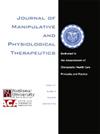Pressure Pain Threshold Protocols With Pressure Algometer in Patients With Low Back Pain: A Systematic Review With Meta-Analysis
IF 1.4
4区 医学
Q4 HEALTH CARE SCIENCES & SERVICES
Journal of Manipulative and Physiological Therapeutics
Pub Date : 2023-06-01
DOI:10.1016/j.jmpt.2024.08.007
引用次数: 0
Abstract
Objective
The pressure pain threshold is commonly employed to assess pain in various conditions. Despite its widespread use, the measurement of pressure pain thresholds is not consistently described across studies. Therefore, this review aimed to systematically examine the evidence regarding the assessment of pressure pain thresholds in patients with low back pain, including the protocols and body sites employed.
Methods
Six databases were systematically screened from their earliest records to May 2023 to identify studies utilizing pressure pain thresholds. Eligibility screening was conducted for the identified studies, and the included studies underwent appraisal using the appropriate tool corresponding to their study design.
Results
Upon categorizing based on the type of pain, we included 5 studies involving acute low back pain and 43 studies with chronic pain. The meta-analysis was conducted to compare subjects with and without pain, revealing no significant difference for the paraspinal region (SMD = −4.19, 95%CI = −11.7 to 3.32, z = −1.09, p = .27), piriformis (SMD = −1.24, 95%CI = −4.25 to 1.76, z = −0.81, p = .42) and quadratus lumborum musculature (SMD = −0.37, 95%CI = −1.35 to 0.60, z = −0.75, p = .45).
Conclusion
The paraspinal and gluteal musculature are the most frequently evaluated. Concerning the protocols for assessment, no consensus was identified. However, studies that assessed chronic low back pain typically adhered to a similar approach regarding the number of measures and a constant increase in pressure.
腰痛患者使用压力阈值规程与压力铝计:带 Meta 分析的系统性综述。
目的:压力痛阈通常用于评估各种情况下的疼痛。尽管压力痛阈被广泛使用,但各项研究对压力痛阈测量的描述并不一致。因此,本综述旨在系统研究有关腰背痛患者压力痛阈值评估的证据,包括采用的方案和身体部位:方法:对六个数据库从最早记录到 2023 年 5 月的数据进行了系统筛选,以确定使用压力痛阈值的研究。对确定的研究进行了资格筛选,并使用与其研究设计相对应的适当工具对纳入的研究进行了评估:根据疼痛类型进行分类后,我们纳入了 5 项涉及急性腰背痛的研究和 43 项涉及慢性疼痛的研究。荟萃分析比较了有疼痛和无疼痛的受试者,结果显示脊柱旁区域无明显差异(SMD = -4.19,95%CI = -11.7 to 3.32,z = -1.09, p = .27)、梨状肌(SMD = -1.24, 95%CI = -4.25 to 1.76, z = -0.81, p = .42)和腰四头肌(SMD = -0.37, 95%CI = -1.35 to 0.60, z = -0.75, p = .45):结论:脊柱旁和臀部肌肉是最常被评估的部位。关于评估方案,尚未达成共识。不过,对慢性腰背痛进行评估的研究通常在测量次数和持续增加压力方面采用类似的方法。
本文章由计算机程序翻译,如有差异,请以英文原文为准。
求助全文
约1分钟内获得全文
求助全文
来源期刊
CiteScore
3.00
自引率
7.70%
发文量
63
审稿时长
29 weeks
期刊介绍:
The Journal of Manipulative and Physiological Therapeutics (JMPT) is an international and interdisciplinary journal dedicated to the advancement of conservative health care principles and practices. The JMPT is the premier biomedical publication in the chiropractic profession and publishes peer reviewed, research articles and the Journal''s editorial board includes leading researchers from around the world.
The Journal publishes original primary research and review articles of the highest quality in relevant topic areas. The JMPT addresses practitioners and researchers needs by adding to their clinical and basic science knowledge and by informing them about relevant issues that influence health care practices.

 求助内容:
求助内容: 应助结果提醒方式:
应助结果提醒方式:


